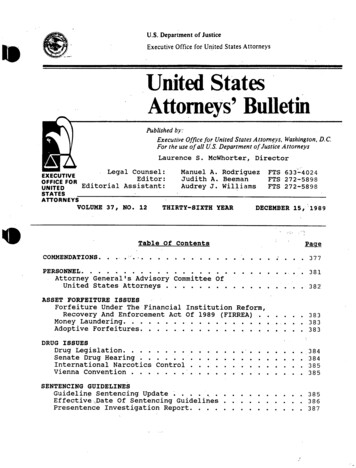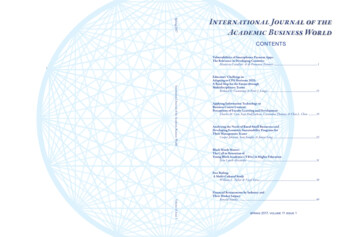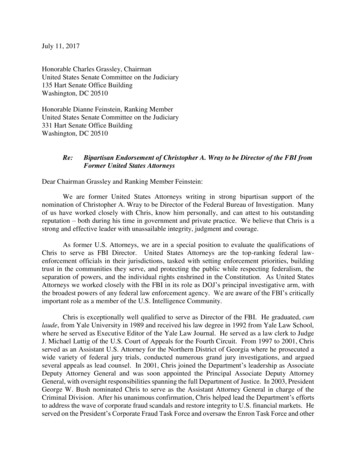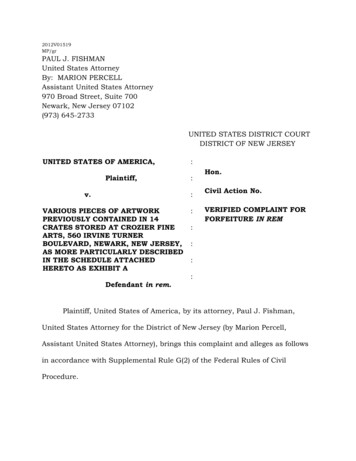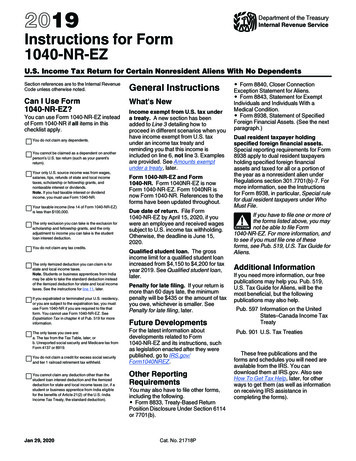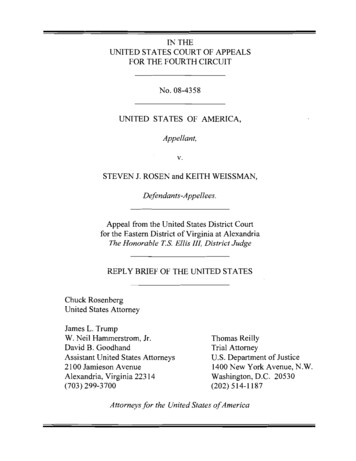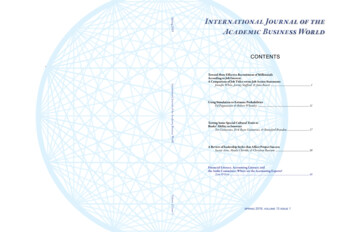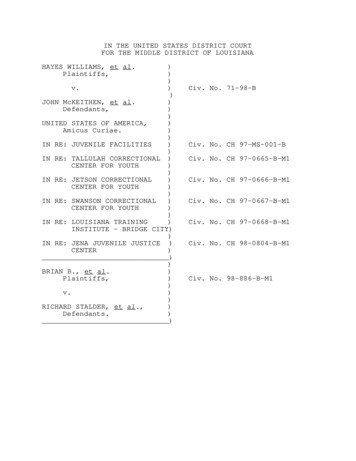
Transcription
IN THE UNITED STATES DISTRICT COURTFOR THE MIDDLE DISTRICT OF LOUISIANAHAYES WILLIAMS, et al.Plaintiffs,)))v.))JOHN McKEITHEN, et al.)Defendants,))UNITED STATES OF AMERICA,)Amicus Curiae.))IN RE: JUVENILE FACILITIES))IN RE: TALLULAH CORRECTIONAL )CENTER FOR YOUTH))IN RE: JETSON CORRECTIONAL)CENTER FOR YOUTH))IN RE: SWANSON CORRECTIONAL)CENTER FOR YOUTH))IN RE: LOUISIANA TRAINING)INSTITUTE - BRIDGE CITY))IN RE: JENA JUVENILE JUSTICE )CENTER)))BRIAN B., et al.)Plaintiffs,))v.)))RICHARD STALDER, et al.,Defendants.))Civ. No. 71-98-BCiv. No. CH 97-MS-001-BCiv. No. CH 97-0665-B-M1Civ. No. CH 97-0666-B-M1Civ. No. CH 97-0667-B-M1Civ. No. CH 97-0668-B-M1Civ. No. CH 98-0804-B-M1Civ. No. 98-886-B-M1
THE UNITED STATES OF AMERICA, )Plaintiff,))v.))THE STATE OF LOUISIANA,))et al.,Defendants.)))A.A., et al.,)Plaintiffs,))v.))WACKENHUT CORRECTIONS CORP., )et al.,)Defendants.))Civ. No. 98-947-B-1Civ. No. 00-246-C-M1TABLE OF CONTENTSI.Introduction (¶1 - ¶9). . . . . . . . . . . . . . . . 3II.Definitions (¶10 - ¶19) . . . . . . . . . . . . . . . 9III. Juvenile Justice (¶20 - ¶75). . . . . . . . . . . . 12IV.Medical, Dental and Mental Health ( ¶76 - ¶116) . . .V.Quality Assurance ( ¶117 - ¶121) . . . . . . . . . . . 77VI.Compliance and Monitoring ( ¶122 - ¶141) . . . . . . . 87260
SETTLEMENT AGREEMENT FOR MEDICAL, DENTAL,MENTAL HEALTH, REHABILITATION ANDJUVENILE JUSTICE ISSUESI.1.INTRODUCTIONThis Agreement is entered among the following: the UnitedStates Department of Justice as identified in ¶ 10 (the“DOJ”), the private plaintiffs as identified in ¶ 14 (the“Plaintiffs”), and the State, as defined in ¶ 19 below.This Agreement settles and resolves four lawsuits (the“Lawsuits”) concerning the juvenile justice, medical,dental, mental health, and rehabilitative services in theState of Louisiana’s secure juvenile facilities.The fourLawsuits settled by this Agreement are: (1) Williams v.McKeithen, Civ. No. 71-98 (including the following subdockets opened in that action:In Re: Juvenile Facilities ,Civ. No. CH 97-MS-001-B; In Re: Tallulah Correctional Centerfor Youth, Civ. No. CH 97-0665-B-M1; In Re: JetsonCorrectional Center for Youth , Civ. No. CH 97-0666-B-M1; InRe: Swanson Correctional Center for Youth , Civ. No. CH 970667-B-M1; In Re: Louisiana Training Institute - BridgeCity, Civ. No. CH 97-0668-B-M1; and In Re: Jena JuvenileJustice Center, Civ. No. CH 98-0804-B-M1);(2) Brian B. v.Stalder, Civ. No. 98-0886-B-1; (3) A.A. v. WackenhutCorrections Corporation, Civ. No. 00-246-CMI; and (4) UnitedStates v. Louisiana, Civ. No. 98-0947-B-1.In order toresolve the juvenile justice, medical, dental, mental3
health, and rehabilitation issues in this litigation, theparties have entered into this Agreement, which, if compliedwith within the time frames specified below, will result inthe dismissal of the Lawsuits, except as provided in ¶ 9below.The terms of this Agreement shall apply to thesecure juvenile facilities operated by or on behalf of theState and any other secure juvenile facility opened duringthe life of the Agreement.All parties agree and recognizethat the obligations contained in this Agreement and anyremedies flowing therefrom are limited to conditions withinthe secure juvenile facilities and do not follow thejuvenile after his/her final discharge from the facility.This provision shall not prevent the DPSC from continuingits current practice of providing short-term medications.This Agreement shall not increase or decrease any rightsthat juveniles held in secure facilities, on parole, or onprobation supervision may or may not have upon their releasefrom secure facilities.2.As part of this Agreement, the Department of Public Safetyand Corrections (“DPSC”) shall revise as necessary itspolicies and procedures to ensure that they are consistentwith the provisions of this Agreement.3.The State denies any allegations upon which the Lawsuits arebased.The State has entered this Agreement in order toavoid the cost and uncertainty of litigation.4.The United States’ Jena Agreement and the Private4
Plaintiffs’ Jena Agreement, both entered on or about April13, 2000, are terminated and are of no further effect.TheState agrees not to house juveniles at the Jena JuvenileJustice Center in Jena, Louisiana during the term of thisAgreement.5.Immediately upon execution of this Agreement, the partiesshall jointly move the Court for an Order to conditionallydismiss the Lawsuits except as provided in ¶ 9 below.Immediately upon execution of this Agreement, the partiesshall jointly move the Court for an Order terminating andrescinding all existing, orders, judgments or decrees thatpurport to address conditions of confinement in Louisiana’ssecure juvenile facilities, except as set forth in thisparagraph:a.Consent orders.The effect of the following consentorders is stayed until either: (a) final dismissal ofthese actions, at which time all consent orders shallbe terminated and shall have no prospective effect; or(b) 120 days following entry of an order reopeningthese actions:April, 1996 Order (Bridge City CorrectionalCenter),November 14, 1996 Order (Swanson CorrectionalCenter for Youth-Monroe),April, 1998 Order (Jetson Correctional Center forYouth), andNovember 15, 1994 Order (Tallulah Correctional5
Center for Youth),February 21, 1995,1995, November 12,December 16, 1997,1998.b.Jurisdictional orders.as modified by orders datedNovember 19, 1996, December 22,1997, November 20, 1997,December 23, 1997 and March 10,The substantive effect of thefollowing orders may have been superceded, modified orrescinded; however, these orders may continue to becited and relied upon by the parties solely for thepurpose of establishing this Court’s jurisdiction, forthe purpose of establishing class counsel or prevailingparty status, and for the purpose of supporting the“Attorney Fee Claims”:June 10, 1975Judgment adopting SpecialMaster's reportAugust 6, 1980Original judgment onattorney's fees/prevailingpartiesJanuary 24, 1983Injunction to stop acceptingjuvenile until populationlimits setFebruary 7, 1983Motion to set populationlimits on juvenile facilitiesDecember 7, 1983Stipulation and Consent Decreefor adult facilitiesApril 24, 1984Juvenile consent decreeNovember 26, 1986Extension of consent decreeJanuary 6, 1988Extension of consent decreeOctober 27, 1988Extension of consent decreeJanuary 30, 1991Class certification orderJune 25, 1990Original appointment ofNordyke and Denlinger6
c.June 25, 1991Ruling setting attorney feeratesJune 30, 1993Extension of Consent Decreesand other JudgmentsDecember 22, 1994Order concerning TCCYJune 23, 1995Order denying Motion byTransamerica DevelopmentSeptember 26, 1996Order granting motion toterminate consent decrees foradult facilities except LSPand the Juvenile FacilitiesApril 1, 1997Order granting motion by torelease adult institutionsexcept LSP and the juvenilefacilitiesSeptember 24, 1998Motion and Order ApprovingSettlement and terminatingconsent decree and supervisionover LSP but preservingclaims regarding JuvenileFacilitiesDecember 9, 1998Minute Entry concerning classcertification in Brian B.April 21, 1999Order granting motion forpartial dismissal of LSPSurviving Orders.All surviving orders shallautomatically terminate upon final dismissal of theseactions (unless previously modified or terminated).The Court shall retain jurisdiction over the claims inthe Lawsuits until the final judgment of dismissal isentered.6.The Motion to Conditionally Dismiss shall include a requestfor the Court to order a “fairness” hearing under Rule 23 ofthe Federal Rules of Civil Procedure as soon as notice can7
be given, pursuant to that Rule.This Agreement shall bevoid if the Court does not approve the settlement at thatfairness hearing.The parties agree to ask the Court tohold in abeyance Plaintiffs’ motion to certify a class inBrian B. v. Stalder and A.A. v. Wackenhut.If the Lawsuitsare reopened, Plaintiffs may reurge these motions.Inconnection with the re-urging of these motions, the Stateagrees to permit Plaintiffs to name replacement classrepresentatives in Williams, Brian B. and/or A.A. and towaive the requirements for exhaustion of administrativeremedies, provided that Plaintiffs have given the Statewritten notice of the claims to be asserted, at least tendays prior to reurging of the motion.7.[deleted]8.[deleted]9.This Agreement compromises and settles all claims assertedin the Lawsuits except:a.Claims pertaining to the validity, applicability andconstitutionality of the administrative remedyprocedure (ARP).Plaintiffs stipulate to the entry ofan order dismissing all claims and allegations relatedto ARPs in the Lawsuits, without prejudice to theirright to reassert those claims either in new actions orin the Lawsuits if the Lawsuits are reopened inaccordance with this Agreement.b.[deleted]8
c.Claims for attorneys fees.This Agreement does notpurport to address Plaintiffs’ claims for attorneysfees in the Lawsuits.II.DEFINITIONS10.The term “DOJ” shall refer to the United States Departmentof Justice.11.The terms “facilities” and “secure juvenile facilities”refer to the Jetson Correctional Center for Youth (JCCY),the Swanson Correctional Center for Youth - Monroe (SCCY),the Bridge City Correctional Center for Youth (BCCY), theSwanson Correctional Center for Youth - Madison (SCCY-M)(formerly known as the Tallulah Correctional Center forYouth), the Juvenile Reception and Diagnostic Center(“JRDC”), and any other facility used for the housing ofjuveniles owned or operated on behalf of the State duringthe operation of this Agreement, but excluding juveniledetention facilities.12.The term "intake" refers to the day that the individualarrives at the reception and diagnostic center for admissioninto the secure juvenile facilities.13.The term "juvenile" refers to any juvenile who has beenadjudicated delinquent and is residing at any facilityduring the operation of this Agreement.14.The term “Plaintiffs” refers to the non-governmental agencyprivate plaintiffs in Williams v. McKeithen, Civ. No. 71-98(M.D. La.); Brian B. v. Stalder, Civ. No. 98-0886-B-1; A.A.9
v. Wackenhut Corrections Corporation , Civ. No. 00-246-C-M1;and the suits entitled In Re: Juvenile Facilities , Civ. No.CH 97-MS-001-B; In Re: Tallulah Correctional Center forYouth, Civ. No. CH 97-0665-B-M1; In Re: Jetson CorrectionalCenter for Youth, Civ. No. CH 97-0666-B-M1; In Re: SwansonCorrectional Center for Youth , Civ. No. CH 97-0667-B-M1; InRe: Louisiana Training Institute - Bridge City , Civ. No. CH97-0668-B-M1; and In Re: Jena Juvenile Justice Center , Civ.No. CH 98-0804-B-M1.15.The term “serious mental illness” shall include disorders ofmood and cognition (with the exception of mentalretardation) that significantly interfere with functioningin at least one essential sphere of the juvenile’s life,e.g.:psychotic disorders, mood disorders, the aggressivelymentally-ill, and juveniles who exhibit self-mutilating orsuicidal behavior.16.The term “mental retardation” refers to significant sub average intellectual functioning with an IntelligenceQuotient (IQ) of 70 or below with concurrent deficits orimpairments in present adaptive functioning in at least twoof the following areas:communication, self care, homeliving, social/interpersonal skills, use of communityresources, self-direction, functional academic skills, work,leisure, health and safety, with onset before age eighteen.17.The term “Provider” shall refer to a department, agency ordivision of Louisiana state government with particular10
expertise in the provision of medical, dental, and mentalhealth care contracted by DPSC to provide medical, dental,and mental health care to juveniles.18.[This paragraph is amended by paragraph 7(A) of the 2003Agreement.In the 2003 Settlement Agreement, the term"serious injury" is replaced with the term "reportableinjury" and a new definition is provided].The term“serious injury” means any injury that threatens ajuvenile’s life or limb, or one that requires urgenttreatment by a doctor, or severely restricts the juvenile’susual activities, or requires follow-up by a doctor.19.The term “State” shall refer to the Governor , the Secretaryof the DPSC, and their employees, agents, contractors, andsuccessors, who are wholly or partially responsible for thecare of juveniles confined in the juvenile facilities, withthe understanding that the Governor’s obligations under thisAgreement have been delegated to the Secretary of the DPSC.As used in this Agreement, the term “State” shall notinclude or mean the Board of Supervisors of Louisiana StateUniversity and Agricultural and Mechanical College (“LSU”)or any of the institutions under its management orsupervision.Notwithstanding any other language orprovision contained in this Agreement, this Agreement shallnot be construed to create any obligations flowing fromProvider or LSU to Plaintiffs or DOJ.As used in thisAgreement, the “State” shall not include the City of11
Tallulah or LaSalle Parish Hospital District Number 2.IIIJUVENILE JUSTICEA.20.Protection from Abuse and ViolenceThe State shall establish and implement policies andprocedures for the purposes of providing juveniles with safeand humane living conditions, protection from physical,sexual, and mental abuse by facility staff, and fromjuvenile-on-juvenile violence and sexual abuse, and otherforms of victimization (such as “strong-arming”).24.Within one month of the effective date of this Agreement,the State shall ensure that:(a) every juvenile who reportsto a facility infirmary with an injury or pain shall bequestioned by a health care staff, outside the hearing ofofficers or other juveniles, regarding the cause of theinjury or pain; and (b) if in the course of the juvenile’sinfirmary visit abuse is alleged or health care staffsuspects abuse, the health care staff shall call the PZTHotline following delivery of necessary medical care andadequately document the matter in the juvenile’s medicalrecord, fill out an incident report, and log the PZT call inthe infirmary log.25.[Pursuant to paragraph 7 of the 2003 Settlement Agreement,the term "serious injury" in this paragraph is replaced withthe term "reportable injury"].Within three months of theeffective date of this Agreement, the State shall ensurethat any allegation or incident involving neglect, abuse,12
excessive use of force, use of any type of chemicalrestraint, or incident/accident resulting in serious injuryis adequately reviewed, investigated, and documented in atimely manner.If a full investigation (see ¶ 26 a - i) isnot warranted, then the reasons why a full investigation isnot conducted shall be documented in writing.In caseswhere a juvenile withdraws an allegation, the investigatorsshall record the investigation on the log, conduct apreliminary investigation to determine the circumstances andreasons for the withdrawal, and in cases where it iswarranted, complete the investigation of the abuseallegation.In no case shall an investigator do aninvestigation on an incident in which he or she waspersonally involved.Whenever practicable, PZTInvestigators will interview juveniles outside of schoolhours; however, a juvenile may be removed from school by aPZT investigator as part of a PZT investigation, and theState shall not be required to comply with all academic andvocational program participation requirements for thatjuvenile for that day.A letter confirming the outcome of the investigationshall be sent to parents/guardians or other close familymembers when those persons have identified themselves at thetime of referral and have provided a mailing address .26.[Pursuant to paragraph 7 of the 2003 Settlement Agreement,the term "serious injury" in this paragraph is replaced with13
the term "reportable injury"].The State shall promulgateand implement system-wide policies for the investigation ofallegations of neglect, abuse, excessive use of force, andincidents and/or accidents resulting in reportable injury.The policies shall identify the types of actions thatnormally would be taken in such an investigation including:a.Taking photographs of all visible injuries;b.Securing, examining and photographing all physicalevidence;c.Interviewing the alleged victim and perpetrator inindividual, private, in-person interviews with a recordmade of the substance of the interview (writtenstatements by staff or juveniles shall not besubstituted for personal interviews);d.Identifying and interviewing privately, separately andin-person, all possible witnesses, including otherjuveniles and staff in the building or unit at the timeof the incident;e.Examining the juvenile’s and staff member'sinstitutional, personnel and other records, includingany prior allegations of abuse against the staff personwhether substantiated or not;f.Staff and juvenile witnesses to the alleged abuse arenot, at any time after an incident, questioned orinterviewed by staff who due to their assignmentsand/or relationship with the alleged perpetrator have14
or appear to have a conflict of interest ininvestigating the allegation;g.Whenever there is reason to believe that a juvenile mayhave been subjected to physical sexual abuse, thejuvenile is examined by non-DPSC health care personnelwith special training and experience in conducting suchassessments;h.For all investigations not completed within ten workingdays, notification detailing the need for additionaltime and an estimate of the additional time neededshall be provided to the supervisory investigators; andi.The investigation makes an explicit determination ofwhether any facility staff knew of, but did not report,the alleged abuse or provided false information duringthe investigation.27.Every PZT investigation shall result in a written report.The report contents will be appropriate to the extent ofinvestigation required to issue a finding.The report shallexplicitly and separately set forth the following asappropriate to the investigation:a.each allegation of wrongdoing investigated;b.the name(s) of all alleged victims and perpetrators;c.the names of all witnesses;d.the names of all persons interviewed during theinvestigation;e.all documents reviewed during the investigation;15
f.whether videotapes were examined and, if not, why not;g.all other sources of evidence considered;h.all PZT investigations and their results , involving thealleged victim(s) and perpetrator(s);i.the investigator’s findings;j.the investigator’s reasons for his or her conclusion.A copy of the summary/conclusion of the investigationof a substantiated allegation will be placed into the fileof the juvenile who is the subject of the investigation.28.The State shall employ trained, independent investigators ateach facility with adequate experience and training ininvestigations to accomplish these tasks.The investigatorsshall prepare comprehensive written investigation reports,setting forth their complete investigative findings and thebasis of their findings.The reports shall besimultaneously forwarded to the facilities’ wardens andsupervising PZT investigators at Headquarters.Theseinvestigators shall report to the wardens of the facilities.If the warden is personally involved in a particularincident, then a PZT investigator assigned from DPSCHeadquarters shall conduct the investigation.29.[Pursuant to paragraph 7 of the 2003 Settlement Agreement,the term "serious injury" in this paragraph is replaced withthe term "reportable injury"].The supervisoryinvestigators shall report to the Office of the Secretaryand shall implement policies and procedures for the16
investigation of allegations of neglect, abuse, violence,excessive use of force, and reportable injury system-wide.30.Within three months of the effective date of this Agreement,the State shall ensure that:a.all employees or contractors against whom physicalabuse or sexual misconduct is substantiated shall beappropriately processed through a performance appraisalaction or disciplinary action.Where significant physical abuse or sexualmisconduct is substantiated, or where there is apattern of substantiated abusive behavior, the employeeor contractor shall be terminated and shall notknowingly be employed at another secure juvenilefacility;b.allegations of criminal sexual misconduct and physicalabuse by staff resulting in lacerations requiringsutures, fractures, serious injuries, or death arereferred for evaluation of the appropriateness ofcriminal prosecution to state authorities, the UnitedStates Attorney’s Office in the district in which thefacility is located, and the Criminal Section of theCivil Rights Division of the Department of Justice; andc.Any staff member under investigation for physical abuseor sexual misconduct shall be separated from anycontact with juveniles or placed on leave if the Statehas a reasonable basis to believe that abuse or sexual17
misconduct warranting termination of employment mayhave occurred.32.[The meaning of the term "misconduct" in this paragraph isclarified in paragraph 15(B) of the 2003 SettlementAgreement].Within nine months of effective date of thisAgreement, the State shall establish the Multiple AllegationDatabase (MAD).This database will be used to screen forstaff with multiple allegations to determine those whosebehavior may need to be modified.a.The MAD shall collect and record the staff’s completename, the date of each allegation of abuse ormisconduct against the staff, the date each allegedevent occurred, the name of the staff or juvenilemaking the allegation of abuse or misconduct againstthe staff, the identifying number of the investigationdone in response to the allegation, the outcome of theinvestigation, and the discipline, training, orcounseling imposed or mandated as a result of theinvestigation, if any.b.The MAD shall be maintained during the staff’semployment and for five years after the staff leavesemployment.c.The Youth Programs Compliance Division shall reviewstaff with three or more allegations of abuse ormisconduct relating to safety or welfare of juvenileswithin a two-year period and, if warranted, take18
appropriate follow-up action (such as meeting with thestaff, recommending remedial training, counseling,transfer, re-assignment, or disciplinary action).33.As part of each PZT investigation, investigators shallexamine the PZT investigation history of the partiesinvolved in the current investigation.This shall includereference to the central PZT registry maintained by theState.34.The State shall document in the personnel record of everyperson hired after the entry of this Agreement that thefacility has consulted the facility records and the centralPZT registry to determine whether the candidate has everbeen the subject of a substantiated PZT investigation at anyfacility in the State and to review any other complainthistory.35.No facility may knowingly hire any individual who has had anallegation of abuse substantiated against him or her thatresulted in termination of employment or resignation toavoid termination.In addition, the MAD shall be checked aspart of the pre-employment review process.And, to theextent possible, the MAD shall be updated within 180 days ofcreation to include all cases of substantiated abuse thatresulted in termination or resignation to avoid disciplinaryaction within the previous 365 days.36.Within four months of the effective date of this Agreement,the State shall confirm that criminal background checks, as19
described herein, have been completed on all existing staffand the State will complete criminal background checks onall prospective employees and existing employees whosebackground check does not conform to the requirements ofthis paragraph.A background check shall include checkingwith the National Crime Information Center and the LouisianaComputerized Criminal History system.The State shallcomplete the above checks on all prospective employeesbefore they have any contact with juveniles.Additionally,finger prints of all employees, existing and prospective,shall be submitted to the State Police in accordance withthe Louisiana Child Protection Act.The State shall takeappropriate action to protect the welfare and safety of thejuveniles based upon the information obtained from thechecks.By April 1, 2002, the State shall provide theUnited States with information identifying all correctionalofficers employed on March 15, 2002 in a manner sufficientfor the United States to review each officer’s arrest andconviction records through the National Crime InformationCenter.During the Private Plaintiffs’ and the UnitedStates’ compliance tour, the State shall provide to theUnited States evidence of the specific personnel actiontaken regarding any employees identified by the UnitedStates with criminal convictions or arrest records.38.The State shall not use corporal punishment on juveniles.B.Staffing/Capacity20
44.Except as provided below, the State shall not permitcorrectional officers working in juvenile housing units towork more than 120 hours in any 14-day period, nor more than5 consecutive days.During an emergency, the Warden mayinitiate a variance to this paragraph.The definition ofemergency shall not include problems associated with under staffing.45.Within three months of the effective date of this Agreement,the State shall develop a plan, timetable and performanceobjectives for reducing turnover and vacancy rates fordirect care staff.The State shall make their best effortsto reduce the annualized turnover rate of direct care staffin each facility to below 100%, and the State shall maketheir best efforts to maintain the number of vacantpositions in each facility at no more than 15% of budgetedpositions within six months of the effective date of thisAgreement.The State shall make their best efforts toreduce the annualized turnover rate of direct care staff ineach facility to below 50%, and the State shall make theirbest efforts to maintain the number of vacant positions ineach facility to no more than 5% of the budgeted positions,within one year of the effective date of this Agreement.A.46.Direct Care Staff TrainingWithin 23 months of the effective date this Agreement, theState shall ensure that all staff who have direct contactwith juveniles are adequately trained and can demonstrate21
competence in the following areas:a.stages of adolescent development;b.communication skills, including specific instruction onverbal de-escalation techniques;c.behavior management and the management of aggressivebehavior;d.basic training relating to juveniles with mental healthissues, including recognizing signs of mentalretardation, developmental disabilities and mentalillness and appropriate methods of interaction withsuch juveniles; grief and loss among juveniles; andmeasuring and monitoring behavior changes;e.crisis prevention and intervention, including theprevention and intervention in suicidal behavior andself-mutilation;f.basic Constitutional and legal rights of juveniles injuvenile facilities;g.report writing;h.basic training relating to medical care, includingbasic medical terminology; recognizing and respondingto seizure disorders; common side effects ofprescription and non-prescription medication; andconfidentiality of medical information;i.the physical and emotional needs of pregnant residents(for staff working with female juveniles);j.universal precautions to prevent infection with TB and22
AIDS;k.certification in first aid and cardiopulmonaryresuscitation;l.accommodations needed for mentally ill and physicallyor developmentally disabled juveniles;m.fire safety and evacuation procedures and conducting ofregular emergency evacuation drills;47.n.use of force policy; ando.Project Zero Tolerance and the grievance system.Within 23 months of the effective date of this Agreement,all direct care staff and all case workers shall be taughteffective, non-punitive ways to manage juveniles.Caseworkers shall have a working knowledge of the rehabilitativeand/or mental health treatment plans of the juveniles intheir care.Direct care staff shall be provided enoughinformation by caseworkers regarding treatment and/orrehabilitative issues of the juveniles in their caseload tofacilitate the direct care staff’s supervision of thejuveniles.48.[The intent of this paragraph is clarified in paragraph 18of the 2003 Settlement Agreement].The State shall ensurethat all staff who have regular and routine contact withjuveniles are adequately trained concerning the standardsfor physical management of juveniles and what constitutesabuse.a.Employees will take all reasonable steps to minimize23
situations requiring a use of force and to minimize theamount of force used in those situations.Whenpossible, actions other than use of force, such asstaff presence, verbal directions and warning, crisisintervention techniques, and passively removing ajuvenile from an area of group activity without the useof physical handling, will be used;b.Force will be used only as a last resort to control thejuveniles;c.The amount of force used will be proportional to thethreat to which it is a response and cease when theresistance ceases;d.Force may be used only:i.To prevent an escape;ii.To prevent an act which could result in death orsevere bodily harm to the juvenile or anotherperson;iii. To defend one’s self or others against a physicalassault;iv.To separate participants in a fight;v.To prevent substantial damage to property; andvi.When necessary, to enforce legal orders andinstructions.e.Whenever possible, force will not be used againstjuveniles with mental illness or mental retardationbefore appropriate medical, mental health, or24
counseling personnel can be called to the scene.f.The first action taken to gain control will be direct,verbal instructions to cease the behavior, unless theemployee perceives that life or health will bejeopardized, or that there is a substantial threat tosecurity.g.When determining the need to use
dental, mental health, and rehabilitative services in the State of Louisiana's secure juvenile facilities. The four Lawsuits settled by this Agreement are: (1) Williams v. McKeithen, Civ. No. 71-98 (including the following sub-dockets opened in that action: In Re: Juvenile Facilities, Civ. No. CH 97-MS-001-B; In Re: Tallulah Correctional Center




